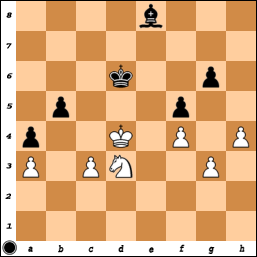A FAIRLY reliable rule in chess is that if you are given the white pieces in the first round of a tournament with an odd number of rounds, you can bet your bottom dollar you will at some stage get two blacks in a row.
At least, it feels a fairly reliable rule, so I was not surprised to get black today in rounds four and five of the Dorset Open in Bournemouth.
Both games reached an ending.
 |
| Position after White played 26.gxf3 in the round-four game Michael Duggan (192) - Spanton (167) |
White had to capture with the pawn as otherwise there was a back-rank mate.
Stockfish9 reckons Black has full equality, while Komodo9 gives White a very small edge.
It is embarrassing how quickly I manage to get a lost position.
26...Rd1+?
Patzer sees a check, patzer gives a check. The problem with this move is that it spends a tempo driving White's king to where it wants to go.
The engines give 26...Rd4 27.Kg2 Kd7, with next-to-no advantage for White.
27.Kg2 Kd7?
Another mistake.
It was not too late to play 27...Rd4, although Black has lost a clear tempo on the above-given line.
28.f4
White has the upper hand, thanks to the weakness of Black's kingside.
28...g6 29.Rh3 h5 30.f5 gxf5 31.Rxh5 Rd3?
Pointless, as White's reply helps him reorganise his forces.
32.Rh3
White is already winning, according to the engines
(1-0, 53 moves).
*******************************************************************************
 |
| Position after Black played 33...Rc7-a7 and offered a draw in the round-five game Bruce Jenks (180) - Spanton (167) |
White is a (doubled) pawn up, but Black's pieces (apart from the king) are more active.
We had just oscillated by playing Nb3-c1-b3-c1/Rc7-a7-c7, and I could see no sensible way for either player to vary.
34.Rb2!?
White activates his rook, relying on the weakness of Black's c pawn.
34...Rxa3 35.Kd2
Protecting the d3 pawn before continuing his activation.
35...Ra8?!
It was only after moving (much too quickly - I later reached more than an hour ahead on the clock) that I saw 35...Rc3!? After 36.Kd2 h5 37.Rb5 Kg7 38.Rxc5 Kg6, Stockfish9 gives Black the upper hand, but Komodo9 reckons the position is dead-equal.
36.Rb5 Rc8 37.a4?!
The 'obvious' 37.Nb3 Re8+ 38.Kf2 Bxd3 39.Rxc5 seemed equal.
The text looks promising at first sight, but I guess BJ missed the following backward bishop-move.
37...Bd7 38.Ra5
I wondered whether White should sac the exchange with 38.Nb3!? Bxb5 39.cxb5. It certainly looks tricky, and is hard to evaluate, especially over-the-board.
38...Rb8 39.Kf2!?
Running to protect the h2 pawn.
The engines prefer 39.Rxc5, but after 39...Rb2 and ...Rxh2, Black's connected passed pawns look very dangerous.
39...Rb2+ 40.Ne2+?
But this is definitely wrong.
White had to play 40.Kg3, when 40...Rb1 41.Ne2 Rd2 is promising for Black.
 |
| White has just played 40.Nc1-e2? |
40...g3+! 41.hxg3 Bg4
The knight cannot be saved.
42.Ra8+ Kg7 43.Re8 Ra2??
It's never too late to blunder. This should have let White off the hook.
44.Re5??
Returning the favour.
44.Ke1 is very close to equal, but after the text the game does not last long.
44...f6 45.Rxc5
Or 45.Re7+ Ke8 46.Re4 Bf5 (another backward bishop-move).
45...Rxe2+ 46.Kf1 Re3 47.a5 Rxd3 48.a6 Ra3 49.Rc7+ Kg6 50.a7 d3 51.Ke1 Ra2 1-0.
*******************************************************************************
I finished with a score of +3=1-1 for a grading performance of 192.
That would have been enough, by a half-point, to win the £50 grading prize. But I actually finished equal 2nd-3rd, which means I should receive a cheque for £130 within 14 days …

















